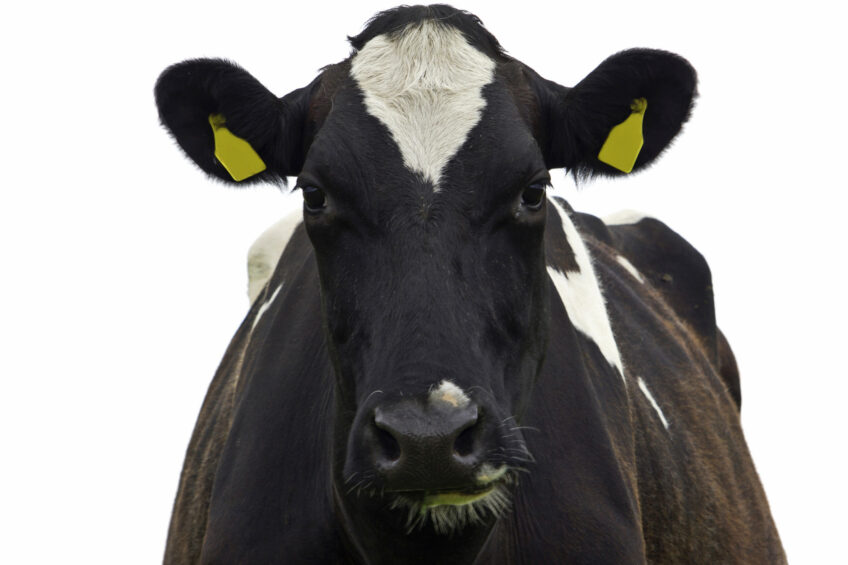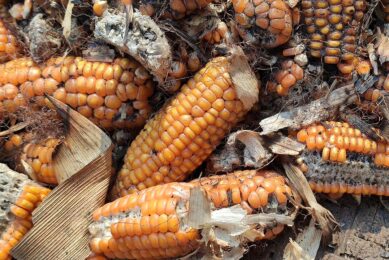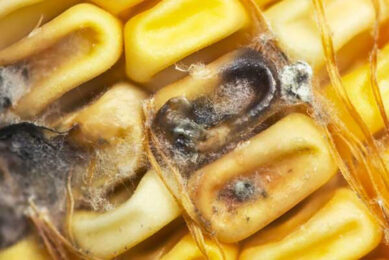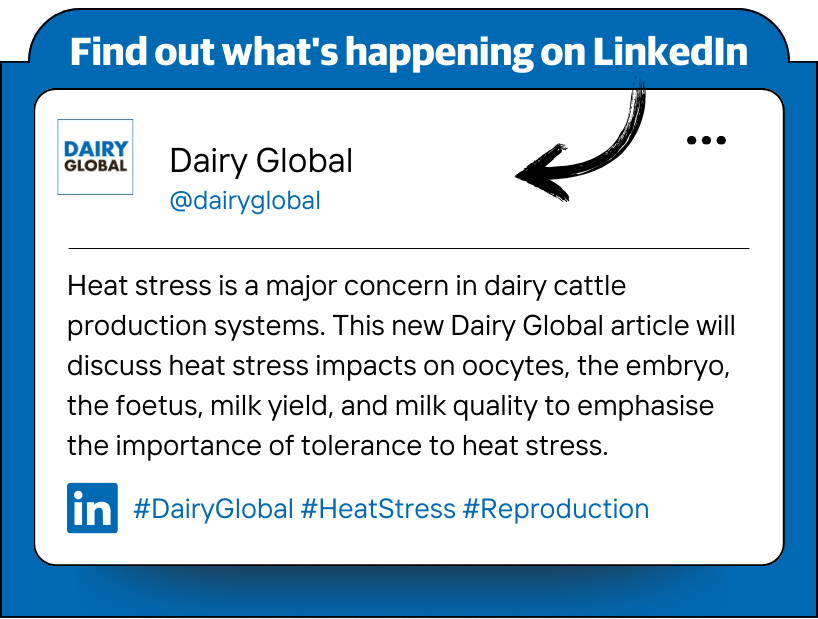Biomin Mycotoxin Survey highlights risks to dairy

When we look at the challenges facing modern high production dairy farming we think of feed utilisation, reproductive success and animal health. What remains hidden is the effect that mycotoxins can have on all 3 of these aspects. The recently published Biomin World Mycotoxin Survey 2016 illustrates risks relevant to dairy cows.
Mycotoxins are produced by fungi to overcome competition from other fungi or bacteria that might be looking to inhabit that same space. When that space is on a crop this becomes a problem for livestock. Mycotoxin producing fungi can grow on grain crops and forage both in the field and after harvest.
The process of making silage adds a further dimension to the mycotoxin risk. The very grains that we use to drive high production in dairy cattle can harbour high levels of deoxynivalenol (DON), zearalenone (ZEN, fumonisins (FUM) and a wide range of other mycotoxins with them. Pasture and forage crops also present risks. Mycotoxin levels tend to fluctuate between years and around regions according to the weather conditions that promote the growth of the responsible fungi. So regular monitoring and survey results are the first steps to a good mycotoxin risk management strategy.
Grain crops
The extent to which cereals and corn are infected by Fusarium disease is largely related to weather conditions during flowering and the lead up to harvest. The recent Northern Hemisphere cereal harvest showed a high risk of DON in cereals in many regions. North American corn harvest has an elevated FUM risk this year on top of a high DON challenge. The South American cereal and corn harvests had lower occurrence of detected mycotoxins than usual in 2016, but the levels of DON in the positive samples was a cause for concern. Soybeans are normally considered a low mycotoxin risk, but with high rainfall at harvest, as seen in some regions this year– the risk can be just as high as in a susceptible crop such as corn. Other mycotoxin risks in grains can include ergots, and a range of other plant diseases.
We need to be careful when bringing grain and soybean crops onto a farm that we do not introduce a significant mycotoxin challenge that could undermine the value that these feeds have for boosting production.
Forage
Mycotoxin contamination in forage also occurs, with ZEN being particularly common. In the case of some grasses there can be ergot alkaloids or lolitrem B (the latter is frequently in perennial ryegrass) from endophyte fungi that actually grow within the plant shoots. Any dead or dying leaf material also presents a challenge. Pay attention to the quality and storage conditions of your forage material so that undesirable fungi do not make matters worse.
Silage process
Good management of silage conditions is critical to achieve quality silage. Improper packing, overly dry silage or breaks in the silage cover promote the growth of undesirable fungi. The levels of the major mycotoxins coming from existing contamination such as DON and other trichothecenes will typically remain roughly constant during ensiling, but other mycotoxins can be added by opportunistic mould fungi. Reviews on mycotoxins in silage have typically highlighted the Aspergillus species toxins such as kojic acid, cyclopiazonic acid and β-nitropropionic acid as well as gliotoxin and the clavine-type compounds from perhaps the most common Aspergillus in silage (A. fumigatus). The reviews have also highlighted Penicillium species toxins such as mycophenolic acid, roquefortines and PR toxin, and citrinins from a variety of fungi including Monascus rubber a common red coloured fungus in silage. Alternaria toxins are also common including kojic acid, alternariols and tenuazonic acid. These compounds also feature in the regular analysis of silages by Biomin using Spectrum 380® (covering more than 380 mycotoxins and fungal metabolites).
Keep up to date on mycotoxins: This interactive tool provides information on the impact on livestock health, A-Z of mycotoxins, previous surveys, plus regulations for mycotoxins per commodity per country.
Mycotoxins in cattle
Traditionally, cattle were assumed to be less sensitive to mycotoxins as a result of rumen fermentation. Rumen microbes are, however, ineffective at degrading some types of mycotoxins such as aflatoxin and ergot alkaloids. In the case of zearalenone, potency can actually be increased by changes in the rumen through formation of alpha-zearalenol. Furthermore, greater production demands and changes in cattle feeding practices have increased opportunities for mycotoxins to negatively impact production and animal health. For the types of mycotoxins that are often partially or largely degraded in a well-functioning rumen, the risk is more likely to be present if something has upset normal rumen function. High rates of feeding, stress conditions, acidosis and feed quality can all impact the rumen’s ability to cope with mycotoxins. Some mycotoxins also impact rumen microorganisms and rumen function themselves, which is not too surprising since the fungi are producing mycotoxins in the first place to act against other microorganisms.
The prevalence of each of 6 major mycotoxins is presented along with the proportion of samples above a risk threshold for effect on dairy cows (dark orange with percentage given in brackets). The risk thresholds for dairy cows are aflatoxins (Afla) 2 ppb, zearalenone (ZEN) 100 ppb, type B trichothecenes (e.g. DON) 500 ppb, type A trichothecenes (e.g.-T2 toxin) 100 ppb, fumonisins (FUM) 2000 ppb and ochratoxin A (OTA) 100 ppb.
Mycotoxin Survey Results
Global results are summarised in Figure 1 for 6 of the main mycotoxin groups over the last six months to better correspond with the recent harvest in the northern hemisphere. Australasia showed the lowest levels but with a recent wet growing season, care should be taken with the early 2017 crop harvests. Aflatoxin (Afla) is often the main mycotoxin concern for milk producers given its potential to carryover in milk as AflaM1. Aflatoxin was present in levels over 2 ppb in a low proportion of samples in each of the continents with Asian (particularly South Asian) and African feed materials typically posing the highest risk. However, the risks of other mycotoxins to the performance of the herd should not be overlooked.
Three of the Fusarium mycotoxins DON, ZEN and FUM were the most common encountered mycotoxins in all six continents. Although an effect of DON on rumen microorganisms has not been clearly demonstrated, it has been shown to affect intestinal microorganisms in other animals and can apparently affect the rumen flow rate. ZEN is most known for its effect on reproductive success. FUM is not taken up very much by ruminants yet effects on cattle have been reported with very high FUM levels in the feed and issues with intestinal health may increase the uptake of this toxin into the blood stream. Both ZEN and FUM have been shown to interact with DON potentially increasing the effect of each mycotoxin on the host animal. The mycotoxins commonly co-occur on cereals and corn (FUM is more commonly present on corn) as they are produced by cereal head blight and corn ear rot Fusarium species.
The effect of T-2 (a type A trichothecene) on intestinal condition in ruminants is more established than that of the type B trichothecenes. The proportion of samples with T2 toxin at levels that could pose a risk to dairy cows was low in prevalence. The toxin potential should not be ignored, however, particularly in crops from cooler parts of Europe and North America. This mycotoxin requires generally cool conditions (e.g. below 15 ºCelsius) to be produced.
Ochratoxin is often completely degraded in the rumen leaving little potential for effect on ruminants although under conditions of heavy feeding (and rumen bypass), as well as stress or poor rumen condition such as acidosis, some amount of ochratoxin may be available to ruminants. The survey data show a low prevalence though in individual samples, the level could be high enough for effect. Ochratoxin is produced by Aspergillus or Penicillium and is typically a storage issue.
Monitoring feed
Given the common multiple occurrence of mycotoxins and the changes in levels and types of mycotoxins that occur over time and between even localised parts of regions, it is important to monitor feeds and to employ strategies that are scientifically proven to address the range of mycotoxin threats present. For most of the major mycotoxins including the common threats of DON (and other trichothecenes) and ZEN, effective biotransformation is required on top of a reliable binder for aflatoxin and ergot alkaloids.
Join 13,000+ subscribers
Subscribe to our newsletter to stay updated about all the need-to-know content in the dairy sector, two times a week.
 Beheer
Beheer









 WP Admin
WP Admin  Bewerk bericht
Bewerk bericht